Water–Energy–Land–Food Nexus Performance and Regional Inequality Toward Low-Carbon Transition in China
Abstract
1. Introduction
2. Methodologies and Materials
2.1. Methods
Panel Data Entropy Method and Comprehensive Index Evaluation Method
2.2. Coupling Coordination Model
2.3. Three-Dimensional Kernel Density Estimation Plot
2.4. Regression Models
2.5. Data Sources and Variables
2.5.1. Explained Variables
2.5.2. Explanatory Variables
2.5.3. Data Sources
3. Results
3.1. Spatial and Temporal Trends of WELF Nexus Performance
WEFL Nexus Performance Level Change
3.2. WEFL Nexus Performance Relevance Level Change
WELF Nexus Performance Level Findings
3.3. Empirical Analysis of Driving Factors Influencing the Relevance Level of WELF Nexus Performance
Benchmark Regression Results
3.4. Regional Inequality in the WELF Nexus
3.5. Robustness Test
4. Discussions and Implications
5. Conclusions
Author Contributions
Funding
Data Availability Statement
Conflicts of Interest
References
- Feenstra, M.; Özerol, G. Energy justice as a search light for gender-energy nexus: Towards a conceptual framework. Renew. Sustain. Energy Rev. 2021, 138, 110668. [Google Scholar] [CrossRef]
- Gaddam, S.J.; Sampath, P.V. Are multiscale water–energy–land–food nexus studies effective in assessing agricultural sustainability? Environ. Res. Lett. 2022, 17, 014034. [Google Scholar] [CrossRef]
- Yao, X.; Chen, W.; Song, C.; Gao, S. Sustainability and efficiency of water-land-energy-food nexus based on emergy-ecological footprint and data envelopment analysis: Case of an important agriculture and ecological region in Northeast China. J. Clean. Prod. 2022, 379, 134854. [Google Scholar] [CrossRef]
- Chen, X.; Chen, M. Energy, environment and industry: Instrumental approaches for environmental regulation on energy efficiency. Environ. Impact Assess. Rev. 2024, 105, 107439. [Google Scholar] [CrossRef]
- Das, A.; Sahoo, B.; Panda, S.N. Evaluation of Nexus-Sustainability and Conventional Approaches for Optimal Water-Energy-Land-Crop Planning in an Irrigated Canal Command. Water Resour. Manag. 2020, 34, 2329–2351. [Google Scholar] [CrossRef]
- Zhang, J.; Yang, Y.C.E.; Abeshu, G.W.; Li, H.; Hung, F.; Lin, C.-Y.; Leung, L.R. Exploring the food-energy-water nexus in coupled natural-human systems under climate change with a fully integrated agent-based modeling framework. J. Hydrol. 2024, 634, 131048. [Google Scholar] [CrossRef]
- Chen, H.; Wang, C. Assessing Environmental, Social, and Governance Risks in the Water, Energy, Land, and Food Nexus, Towards a Just Transition to Sustainable Energy in China. Land 2025, 14, 669. [Google Scholar] [CrossRef]
- Zheng, D.; An, Z.; Yan, C.; Wu, R. Spatial-temporal characteristics and influencing factors of food production efficiency based on WEF nexus in China. J. Clean. Prod. 2022, 330, 129921. [Google Scholar] [CrossRef]
- Heffron, R.J.; McCauley, D. The ‘just transition’ threat to our Energy and Climate 2030 targets. Energy Policy 2022, 165, 112949. [Google Scholar] [CrossRef]
- Zou, Y.; Wang, M. Does environmental regulation improve energy transition performance in China? Environ. Impact Assess. Rev. 2024, 104, 107335. [Google Scholar] [CrossRef]
- Dong, Y.; Zhang, Y.; Liu, S. The impacts and instruments of energy transition regulations on environmental pollution. Environ. Impact Assess. Rev. 2024, 105, 107448. [Google Scholar] [CrossRef]
- Elagib, N.A.; Al-Saidi, M. Balancing the benefits from the water–energy–land–food nexus through agroforestry in the Sahel. Sci. Total Environ. 2020, 742, 140509. [Google Scholar] [CrossRef] [PubMed]
- Favi, S.G.; Adamou, R.; Godjo, T.; Giri, N.C.; Kuleape, R.; Trommsdorff, M. Agrivoltaic systems offer symbiotic benefits across the water-energy-food-environment nexus in West Africa: A systematic review. Energy Res. Soc. Sci. 2024, 117, 103737. [Google Scholar] [CrossRef]
- Gao, Y.; Zhang, H.; Shi, X.; Wang, Y. Coupling Coordination Analysis of the Water–Land–Energy–Food–Carbon Nexus: A Case Study of Beijing. J. Urban Plan. Dev. 2025, 151, 05025016. [Google Scholar] [CrossRef]
- Zhang, R.; Worden, S.; Xu, J.; Owen, J.R.; Shi, G. Social stability risk assessment and economic competitiveness in China. Humanit. Soc. Sci. Commun. 2022, 9, 309. [Google Scholar] [CrossRef]
- Gazal, A.A.; Jakrawatana, N.; Silalertruksa, T.; Gheewala, S.H. Water-energy-land-food nexus for bioethanol development in Nigeria. Biomass Convers. Biorefinery 2024, 14, 1749–1762. [Google Scholar] [CrossRef]
- Heffron, R.J. Applying energy justice into the energy transition. Renew. Sustain. Energy Rev. 2022, 156, 111936. [Google Scholar] [CrossRef]
- Ibrahim, M.D.; Ferreira, D.C.; Daneshvar, S.; Marques, R.C. Transnational resource generativity: Efficiency analysis and target setting of water, energy, land, and food nexus for OECD countries. Sci. Total Environ. 2019, 697, 134017. [Google Scholar] [CrossRef]
- Jiang, T.; Zhang, R.; Zhang, F.; Shi, G.; Wang, C. Assessing provincial coal reliance for just low-carbon transition in China. Environ. Impact Assess. Rev. 2023, 102, 107198. [Google Scholar] [CrossRef]
- Keson, J.; Silalertruksa, T.; Gheewala, S.H. Land suitability class and implications to Land-Water-Food Nexus: A case of rice cultivation in Thailand. Energy Nexus 2023, 10, 100205. [Google Scholar] [CrossRef]
- Akbar, H.; Nilsalab, P.; Silalertruksa, T.; Gheewala, S.H. An inclusive approach for integrated systems: Incorporation of climate in the water-food-energy-land nexus index. Sustain. Prod. Consum. 2023, 39, 42–52. [Google Scholar] [CrossRef]
- Chapman, A.; Shigetomi, Y.; Ohno, H.; McLellan, B.; Shinozaki, A. Evaluating the global impact of low-carbon energy transitions on social equity. Environ. Innov. Soc. Transit. 2021, 40, 332–347. [Google Scholar] [CrossRef]
- Amadei, B. A systems approach to the sustainability–peace nexus. Sustain. Sci. 2021, 16, 1111–1124. [Google Scholar] [CrossRef]
- Banerjee, A.; Schuitema, G. How just are just transition plans? Perceptions of decarbonisation and low-carbon energy transitions among peat workers in Ireland. Energy Res. Soc. Sci. 2022, 88, 102616. [Google Scholar] [CrossRef]
- Kitessa, B.D.; Ayalew, S.M.; Gebrie, G.S.; Teferi, S.T. Optimization of urban resources efficiency in the domain of water–energy–food nexus through integrated modeling: A case study of Addis Ababa city. Water Policy 2022, 24, 397–431. [Google Scholar] [CrossRef]
- Burke, M.J. Energy-Sufficiency for a Just Transition: A Systematic Review. Energies 2020, 13, 2444. [Google Scholar] [CrossRef]
- Li, Y.; Zhang, R. A Review of Water-Energy-Food Nexus Development in a Just Energy Transition. Energies 2023, 16, 6253. [Google Scholar] [CrossRef]
- Wang, X.; Zhang, R.; Jiang, T. Energy justice and decarbonization: A critical assessment for just energy transition in China. Environ. Impact Assess. Rev. 2024, 105, 107420. [Google Scholar] [CrossRef]
- Yang, K.; Han, Q.; Yang, D.; De Vries, B. Exploring the Relationship Between Land Use and the Food-Water-Energy Nexus: Insights From A Systematic Literature Review. Land Degrad. Dev. 2025, 36. [Google Scholar] [CrossRef]
- Lucca, E.; El Jeitany, J.; Castelli, G.; Pacetti, T.; Bresci, E.; Nardi, F.; Caporali, E. A review of water-energy-food-ecosystems Nexus research in the Mediterranean: Evolution, gaps and applications. Environ. Res. Lett. 2023, 18, 083001. [Google Scholar] [CrossRef]
- Mansour, F.; Al-Hindi, M.; Yassine, A.; Najjar, E. Multi-criteria approach for the selection of water, energy, food nexus assessment tools and a case study application. J. Environ. Manag. 2022, 322, 116139. [Google Scholar] [CrossRef] [PubMed]
- Prinsloo, F.C.; Schmitz, P.; Lombard, A. System dynamics characterisation and synthesis of floating photovoltaics in terms of energy, environmental and economic parameters with WELF nexus sustainability features. Sustain. Energy Technol. Assess. 2023, 55, 102901. [Google Scholar] [CrossRef]
- Carley, S.; Konisky, D.M. The justice and equity implications of the clean energy transition. Nat. Energy 2020, 5, 569–577. [Google Scholar] [CrossRef]
- Ni, Y.; Chen, Y. Does the implementation sequence of adaptive management countermeasures affect the collaborative security of the water-energy-food nexus? A case study in the Yangtze River Economic Belt. Ecol. Indic. 2024, 163, 112090. [Google Scholar] [CrossRef]
- Okumu, B.; Kehbila, A.G.; Osano, P. A review of water-forest-energy-food security nexus data and assessment of studies in East Africa. Curr. Res. Environ. Sustain. 2021, 3, 100045. [Google Scholar] [CrossRef]
- Sall, M.T.; Diop, P.; Wellens, J.; Seck, M.; Chopart, J.L. A Framework for IWRM in the Water-Energy-Food Nexus for the Senegal River Delta. In Climate Change and Water Resources in Africa; Diop, S., Scheren, P., Niang, A., Eds.; Springer International Publishing: Berlin/Heidelberg, Germany, 2021; pp. 145–170. [Google Scholar] [CrossRef]
- Tang, M.; Li, Z.; Hu, F.; Wu, B. How does land urbanization promote urban eco-efficiency? The mediating effect of industrial structure advancement. J. Clean. Prod. 2020, 272, 122798. [Google Scholar] [CrossRef]
- Wang, X.; Lo, K. Just transition: A conceptual review. Energy Res. Soc. Sci. 2021, 82, 102291. [Google Scholar] [CrossRef]
- Yu, Y.; Li, K.; Duan, S.; Song, C. Economic growth and environmental pollution in China: New evidence from government work reports. Energy Econ. 2023, 124, 106803. [Google Scholar] [CrossRef]
- Cao, Y.; Mi, W.; Zhang, R. Provincial ESG performance in China: Evolution trends and the role of environmental regulation. Environ. Impact Assess. Rev. 2024, 107, 107570. [Google Scholar] [CrossRef]
- Ringler, C.; Bhaduri, A.; Lawford, R. The nexus across water, energy, land and food (WELF): Potential for improved resource use efficiency? Curr. Opin. Environ. Sustain. 2013, 5, 617–624. [Google Scholar] [CrossRef]
- Yuan, M.; Zheng, N.; Yang, Y.; Liu, C. Robust optimization for sustainable agricultural management of the water-land-food nexus under uncertainty. J. Clean. Prod. 2023, 403, 136846. [Google Scholar] [CrossRef]

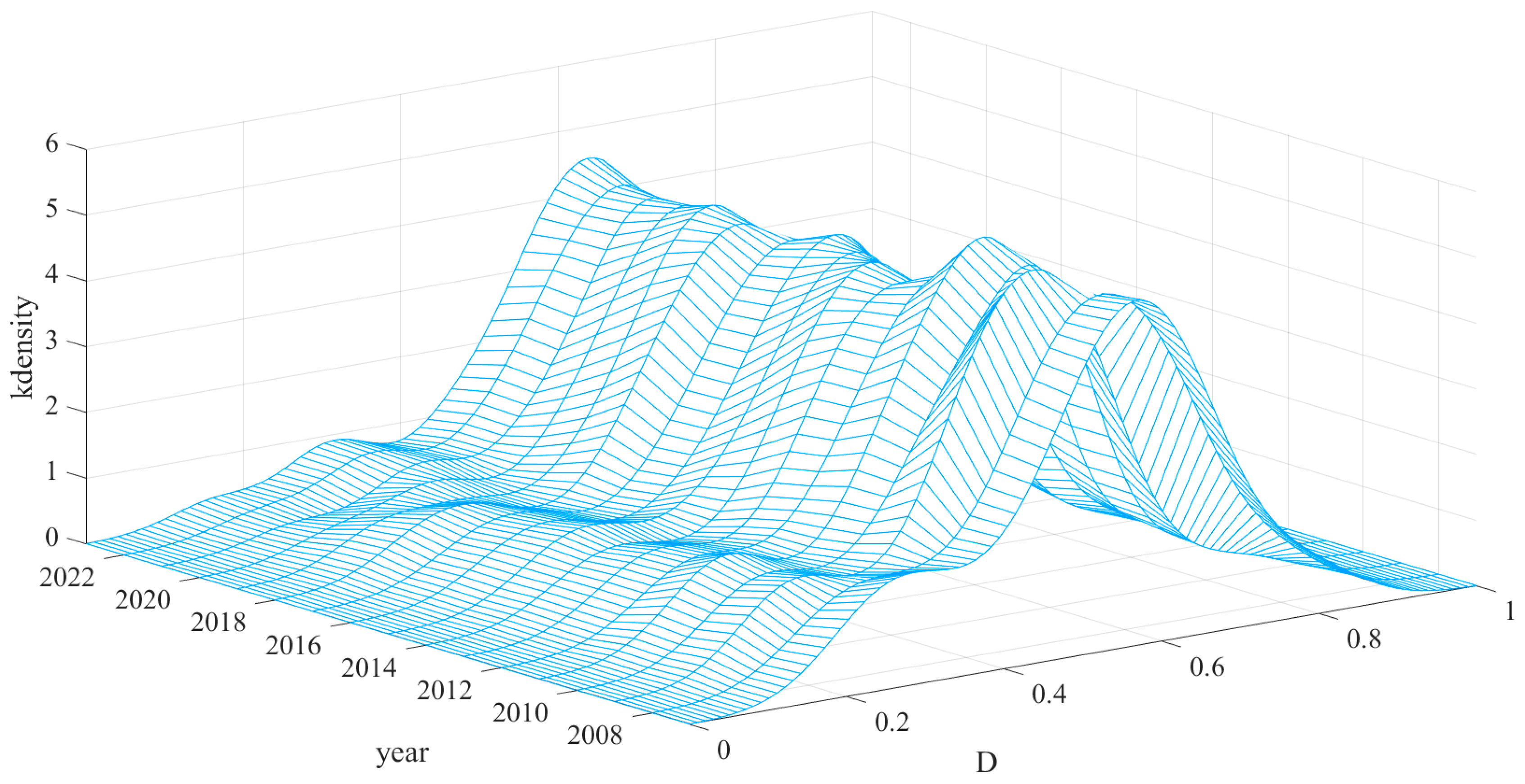

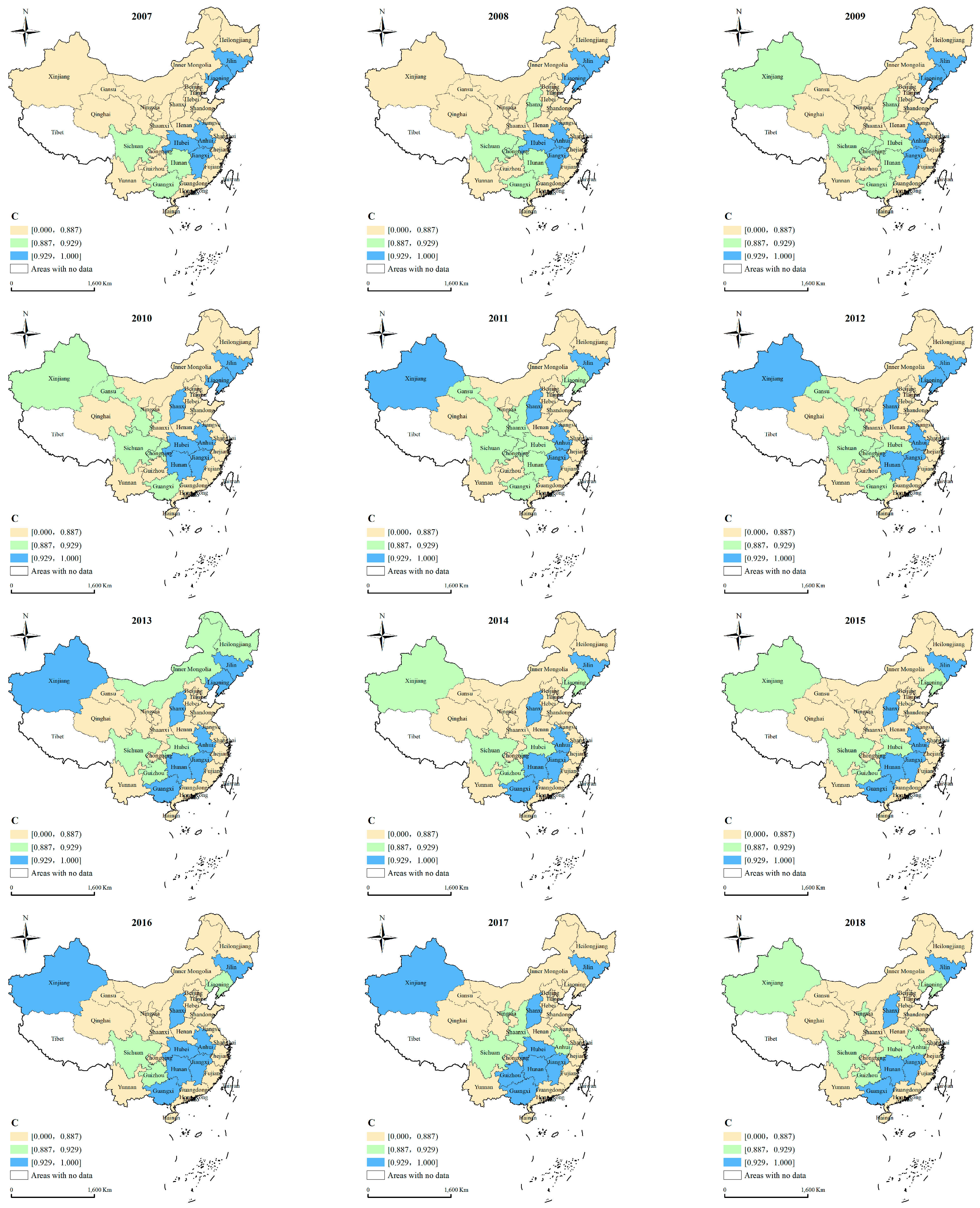
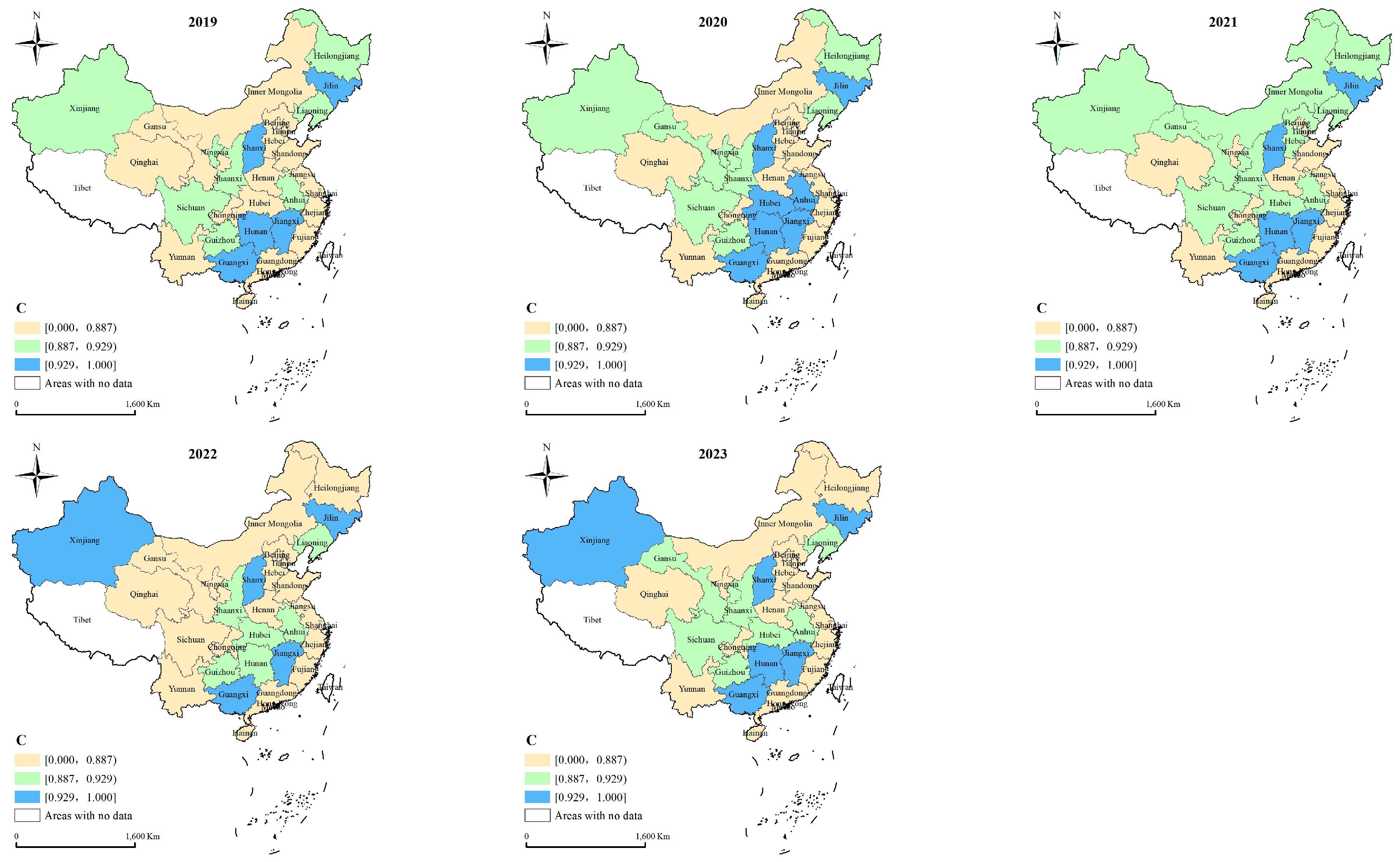
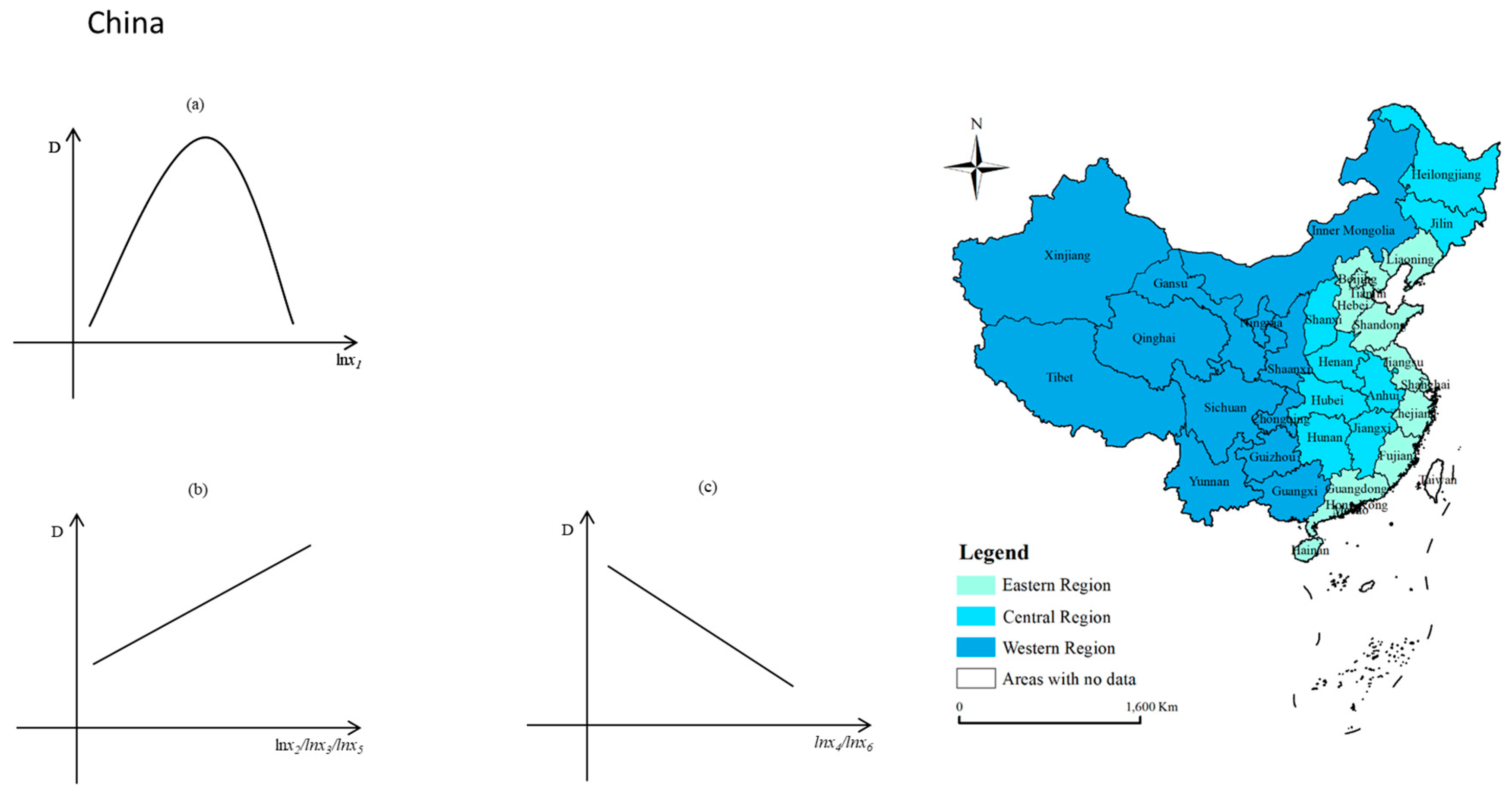
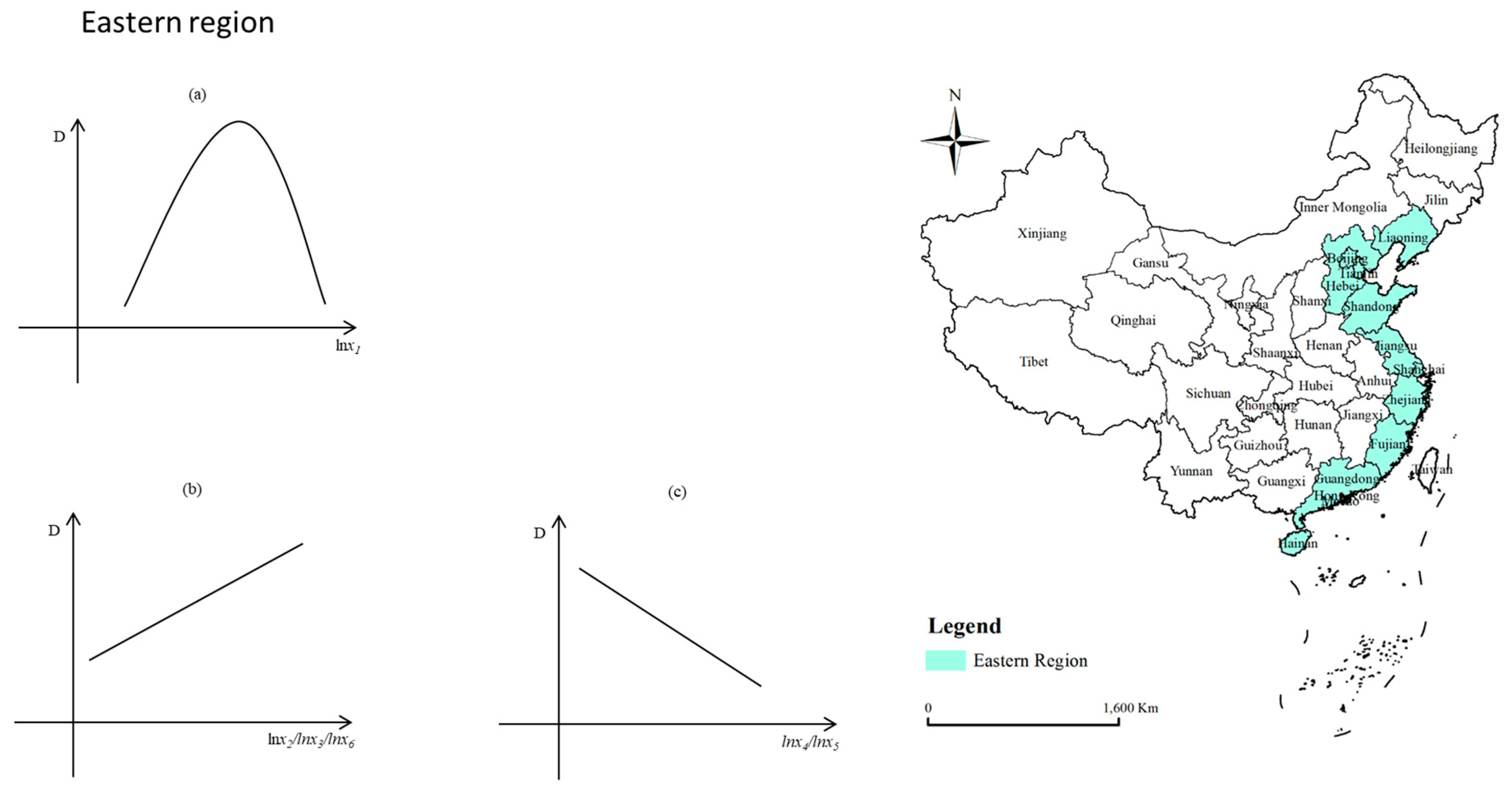


| Dimensions | Indicators | Direction |
|---|---|---|
| Water | Water resources per capita | Positive |
| Water consumption per capita | Negative | |
| Industrial water consumption | Negative | |
| Agricultural water use | Negative | |
| Energy | Energy consumption per unit of GDP | Negative |
| Energy consumption growth rate | Negative | |
| Proportion of clean energy consumption | Positive | |
| Proportion of coal energy consumption | Negative | |
| Land | Arable land | Positive |
| Woodland area | Positive | |
| Land for transportation | Positive | |
| Land transfer rate | Negative | |
| Food | Food production per capita | Positive |
| Fluctuations in food production | Positive | |
| Grain production | Positive | |
| Non-grain yields | Positive |
| Variable Symbol | Variable Meaning | Sample Size | Mean | Standard Deviation | Minimum | Maximum |
|---|---|---|---|---|---|---|
| C | Degree of coupling (performance level) | 510 | 0.84 | 0.18 | 0.17 | 0.99 |
| D | Coupling coordination (performance relevance level) | 510 | 0.50 | 0.10 | 0.20 | 0.72 |
| X1 | Economic development level | 510 | 52,862.51 | 32,669.14 | 7778.00 | 200,278.00 |
| X2 | Industrialization level | 510 | 41.56 | 8.39 | 14.91 | 61.96 |
| X3 | Market-oriented level | 510 | 7.96 | 1.93 | 3.36 | 12.86 |
| X4 | Human capital level | 510 | 2714.40 | 980.70 | 904.00 | 6964.00 |
| X5 | Population density | 510 | 9695.48 | 5933.03 | 1330.90 | 29,304.95 |
| X6 | Environmental regulation | 510 | 55.17 | 19.54 | 6.00 | 124.00 |
| Variables | Explained Variable: Performance Relevance Level | |||
|---|---|---|---|---|
| (1) | (2) | (3) | (4) | |
| lnx1 | 0.962 *** | 0.824 *** | 1.162 *** | 1.189 *** |
| (0.125) | (0.119) | (0.123) | (0.124) | |
| lnx12 | −0.048 *** | −0.044 *** | −0.057 *** | −0.059 *** |
| (0.006) | (0.006) | (0.006) | (0.006) | |
| lnx2 | 0.023 ** | 0.260 ** | 0.260 ** | |
| (0.011) | (0.013) | (0.013) | ||
| lnx3 | 0.149 *** | 0.187 *** | 0.186 *** | |
| (0.017) | (0.017) | (0.017) | ||
| lnx4 | −0.069 *** | −0.071 *** | ||
| (0.011) | (0.011) | |||
| lnx5 | 0.014 *** | 0.015 *** | ||
| (0.005) | (0.005) | |||
| lnx6 | −0.012 * | |||
| (0.007) | ||||
| Constant | −4.357 *** | −3.822 *** | −5.358 *** | −5.466 *** |
| (0.674) | (0.631) | (0.648) | (0.649) | |
| Sample size | 510 | 510 | 510 | 510 |
| R2 | 0.422 | 0.495 | 0.521 | 0.522 |
| Year fixed effects | Control | Control | Control | Control |
| Region fixed effects | Control | Control | Control | Control |
| Variables | Explained Variable: Performance Relevance Level | ||
|---|---|---|---|
| Eastern Region (1) | Central Region (2) | Western Region (3) | |
| lnx1 | 1.028 *** | 0.558 | −0.092 |
| (0.191) | (0.540) | (0.255) | |
| lnx12 | −0.052 *** | −0.026 | 0.013 |
| (0.009) | (0.025) | (0.012) | |
| lnx2 | 0.066 *** | −0.217 *** | −0.397 *** |
| (0.018) | (0.030) | (0.042) | |
| lnx3 | 0.101 ** | 0.118 *** | 0.155 *** |
| (0.043) | (0.037) | (0.022) | |
| lnx4 | −0.133 *** | 0.105 *** | −0.041 ** |
| (0.015) | (0.026) | (0.018) | |
| lnx5 | −0.061 *** | 0.052 *** | 0.065 *** |
| (0.008) | (0.008) | (0.006) | |
| lnx6 | 0.028 *** | −0.005 | −0.003 |
| (0.009) | (0.011) | (0.010) | |
| Constant | −3.645 *** | −3.279 | 0.827 |
| (1.015) | (2.893) | (1.366) | |
| Sample size | 187 | 136 | 187 |
| R2 | 0.668 | 0.583 | 0.580 |
| Variables | Explained Variable: Performance Relevance Level | |||
|---|---|---|---|---|
| (1) | (2) | (3) | (4) | |
| lnx1 | 0.989 *** | 0.847 *** | 1.180 *** | 1.212 *** |
| (0.131) | (0.125) | (0.129) | (0.130) | |
| lnx12 | −0.050 *** | −0.045 *** | −0.058 *** | −0.060 *** |
| (0.006) | (0.006) | (0.006) | (0.006) | |
| lnx2 | 0.026 ** | 0.029 ** | 0.029 ** | |
| (0.012) | (0.013) | (0.013) | ||
| lnx3 | 0.148 *** | 0.187 *** | 0.186 *** | |
| (0.017) | (0.018) | (0.018) | ||
| lnx4 | −0.069 *** | −0.071 *** | ||
| (0.011) | (0.011) | |||
| lnx5 | 0.015 *** | 0.016 *** | ||
| (0.005) | (0.005) | |||
| lnx6 | −0.012 * | |||
| (0.007) | ||||
| Constant | −4.477 *** | −3.934 *** | −5.452 *** | −5.586 *** |
| (0.708) | (0.663) | (0.678) | (0.680) | |
| Sample size | 480 | 480 | 480 | 480 |
| R2 | 0.426 | 0.499 | 0.526 | 0.527 |
| Year fixed effects | Control | Control | Control | Control |
| Region fixed effects | Control | Control | Control | Control |
Disclaimer/Publisher’s Note: The statements, opinions and data contained in all publications are solely those of the individual author(s) and contributor(s) and not of MDPI and/or the editor(s). MDPI and/or the editor(s) disclaim responsibility for any injury to people or property resulting from any ideas, methods, instructions or products referred to in the content. |
© 2025 by the authors. Licensee MDPI, Basel, Switzerland. This article is an open access article distributed under the terms and conditions of the Creative Commons Attribution (CC BY) license (https://creativecommons.org/licenses/by/4.0/).
Share and Cite
Yao, Q.; Cao, H.; Zhang, R. Water–Energy–Land–Food Nexus Performance and Regional Inequality Toward Low-Carbon Transition in China. Land 2025, 14, 1343. https://doi.org/10.3390/land14071343
Yao Q, Cao H, Zhang R. Water–Energy–Land–Food Nexus Performance and Regional Inequality Toward Low-Carbon Transition in China. Land. 2025; 14(7):1343. https://doi.org/10.3390/land14071343
Chicago/Turabian StyleYao, Qi, Hailin Cao, and Ruilian Zhang. 2025. "Water–Energy–Land–Food Nexus Performance and Regional Inequality Toward Low-Carbon Transition in China" Land 14, no. 7: 1343. https://doi.org/10.3390/land14071343
APA StyleYao, Q., Cao, H., & Zhang, R. (2025). Water–Energy–Land–Food Nexus Performance and Regional Inequality Toward Low-Carbon Transition in China. Land, 14(7), 1343. https://doi.org/10.3390/land14071343






